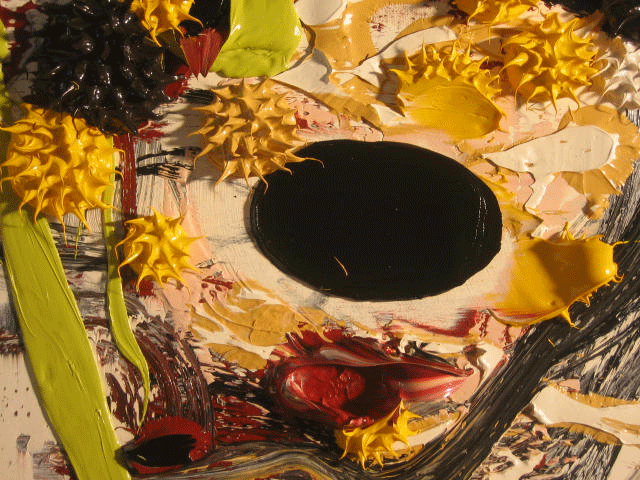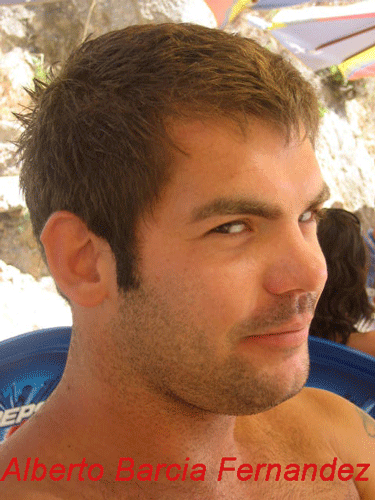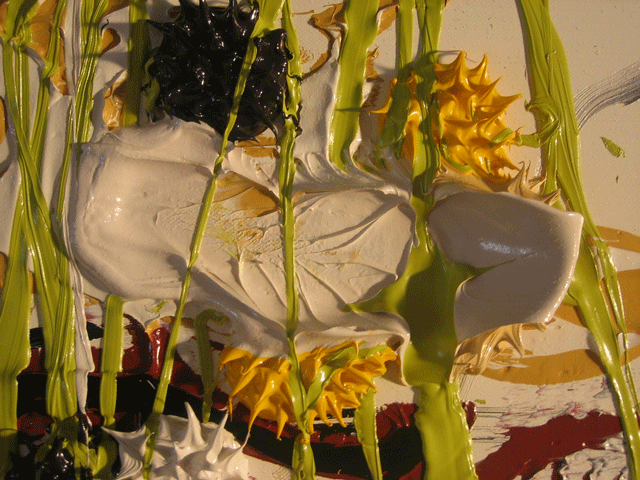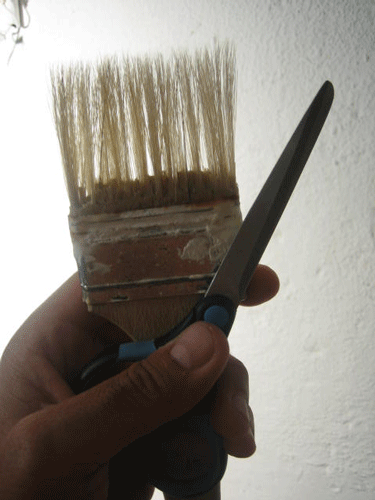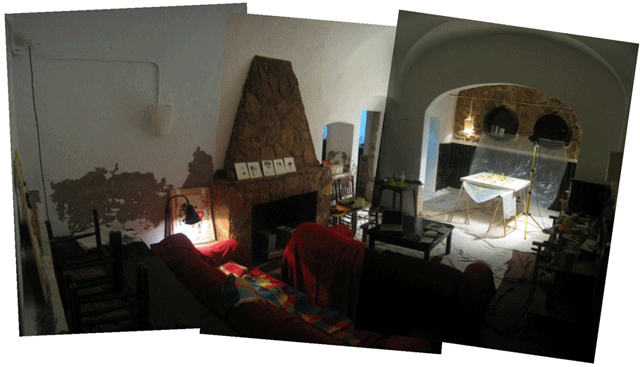July 31, 2006
Horizon Lines
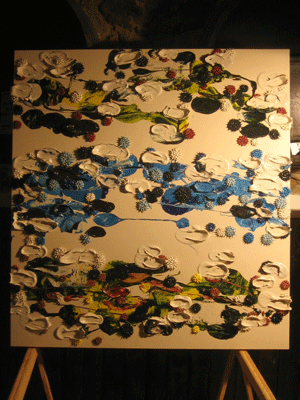
I'm feeling a little bearish right now, pardon the paucity of words.
Here's a bigger pic to overcompensate for the reduction (flattening?):
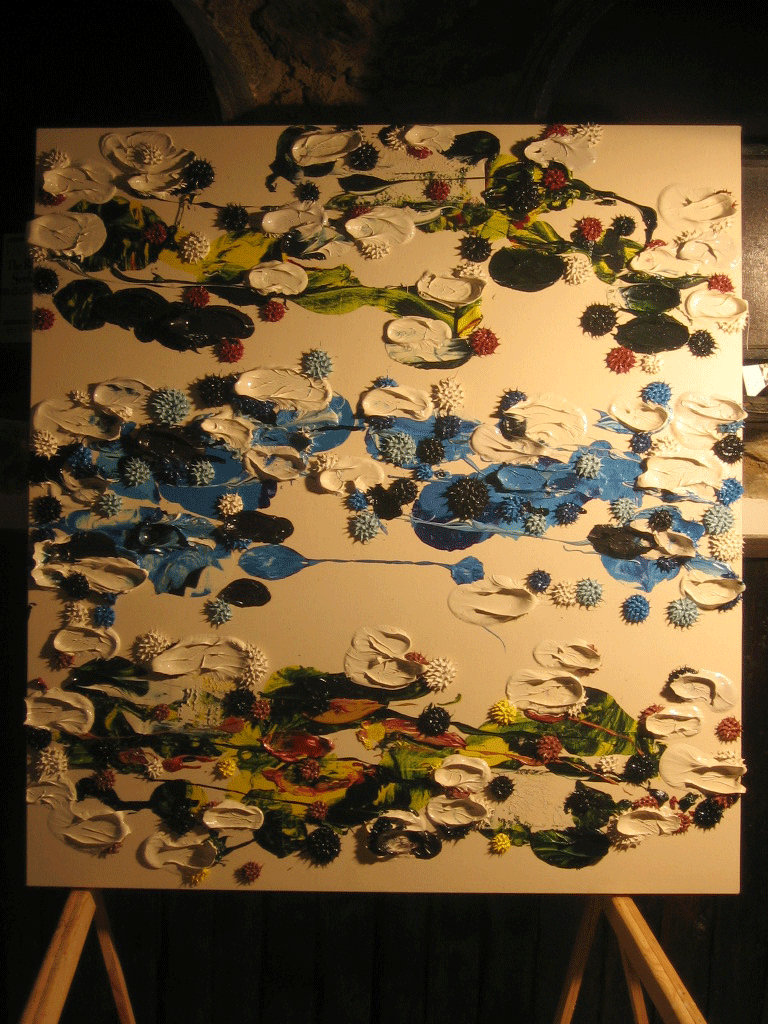
July 29, 2006
Tom Moody

Many thanks to Tom Moody for the recent post regarding the fruit of the studio. I deeply appreciate this digital handshaking between blogged studios, notably Tom's and a host of others: Brent Hallard (thanks for the image post in May, Brent), Chris Ashley, Christopher Jagers, Steve LaRose and Harold ('cuz) Hollingsworth. Look for their links in the soup to the left.
Tom's commentary is close to the work. The reference to suggestion is good to read since literal rendering in our super mediated image flooded age is a flaming sword that keeps me away from the garden of representation. The reference to physics is something I consider to be a search for information rich material qualities, a kind of ballistics* of liquid stone arrested by a picture plane. I see an arc from Vietnam era cluster bombs to Gulf War precision bomb J-Dams that is the same arc from Pollock to Lasker. A "Less is More", information age arc. The big question now is the movement forward over our horizon.
I appreciate Tom's comment: "Close-up, the paintings have many details that confound your attempts to mentally reconstruct how or in what order the paint was applied." . I tend to think of the order of execution in terms of a kind of super fluidity, of how one action can be erased or amplified by the next; that each touch has good and not so good aspects; of how each action is an edit on the previous one and the whole painting is a chain of these edits; of the way it is like a card game, where each house is a strictly ordered system (hearts to clubs, ace to king) that is shuffled and re-ordered into a unique pattern that is relevant to the specific character and circumstances of the game at hand. Poker faces, bets, antes and bluffs.
The reference to thick and buttery is unavoidable and understandable since I see what I'm doing as one in affirmation of painting rather than the legacy of negation that preceded me (the anti-aesthetic, the subordination of paint to photography, to conceptualism of various guises, etc). So I wasn't surprised either to read Bill's terse dismissal. Winky-smart-linked-one liners is what killed ArtForum's chat room (what was the name?) and is what is now rendering PaintersNYC lifeless (Sorry PNYC! You're still in my bookmarks!).
Yea, it's all cake decoration, nothing to see here, time to move along now.
And commenter Robert Huffmann, what a guy! After pooping on the possibilities of longevity of the paint material, he goes on to levy market anxiety ("collectors sweeping them up"? what kind of mentality is that?) and finally, he casually drops a dismissal: "I cut and peel in a similar fashion all the time. It's simple enough with acrylics." Send me a jpeg, Robert. School me.
Wuh.
Anyways.
Though it's not that the discussion about technical matters is irrelevant. It is the implications that follow that interest me. For example: the issue of the compaction of paint as it dries and the tendency for surface features to become more pronounced as the paint dries ultimately forms an outer limit for the impasto thickness of the paint mass. Therefore thickness for it's own sake is not the objective and should be modulated down. Shape and shadow however, muy bien, tio.
The paint will dry over time from the exterior to the interior and they will dry completely, I've tested for this a while ago. What is interesting is that since much of the paint form comes from the natural repose of the material, a structural system in engaged, for example: the monads are a series of organic conic shapes crowded together on a hemisphere, as each tip cowlicks to a point. As the paint dries, the cones compact slightly into hardened self supporting forms. Awareness of limits is not a limitation but a doorway towards possibilities. Intimate knowledge of the performance characteristics of paint material is the grail, the levels get deeper and more subtle as I go. That's a big part of why I've been on this track for over ten years now.
Too much discussion of technique seems a bit carnal, doesn't it? Painter's porn. Well, let's slip down to the full Monty and get down and dirty, let's demystify thusly:
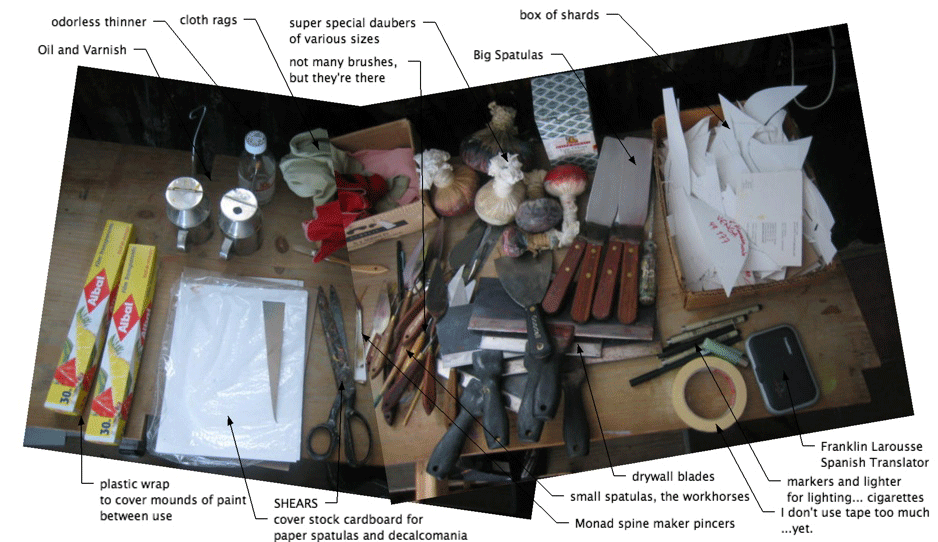
Oh yea, and as for the monads, here's a shot of the origami like pincers to pull the tips and here's a shot of the daubers just because.
*No offense to those who wince at military references. I lived that life, grew up in it, I've been to the ivory tower too and of course our artworld... most people in our culture-verse have a torqued idea of what the American military world is and is all about. If you do, please stay tuned, I hope to challenge your preconceptions.
July 27, 2006
July 26, 2006
Ahora
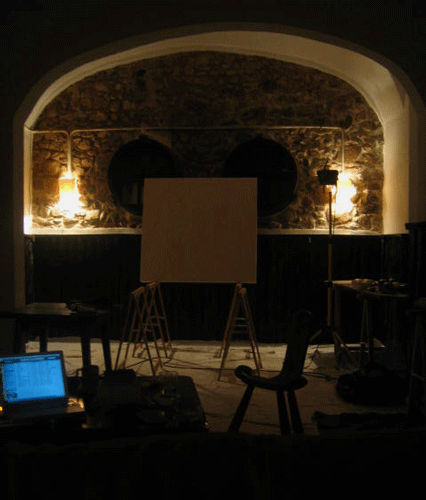
The first painting took one day of pacing, fretting, painting in dotted lines... before I got wet. The second took two days. This third one looks like a three-er.
Snorkel Notes
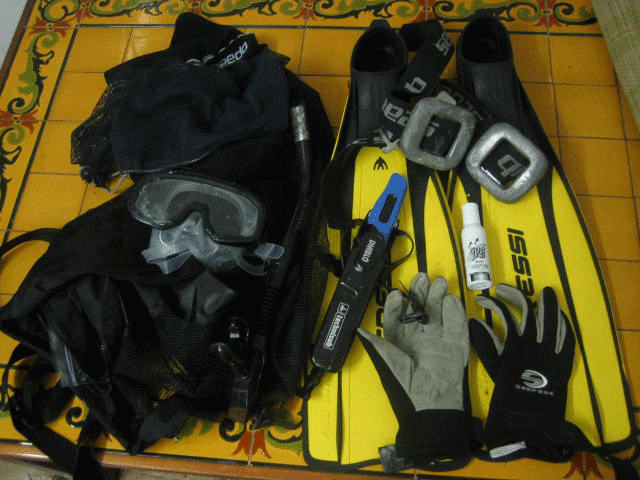
I wrote to my friend Robbie recently, describing my snorkel routine:
I've got my quick snorkel routine down like NASCAR: Today out the door at 5:06.GEAR: towel, sunglasses, keys, a few Euros for a cortado just in case, Speedo, flip flops, fins, gloves (the big revolution in snorkelworld this year), mask and snorkel.? Out and over to Codolar Cove where I've built a little stone hut for fishes and octopus, two walls and two large slabs for a roof.? It's out in the middle of the sandy seafloor like a drawing on clean paper.? Fish love it.? I'm working on the perfecting it for octopus.? I've tried to chase a few over, their skins changing dynamically match their surrounds, jets of ink to cover their getaway.? ?It's like playing in the best aquarium in the world.? Back to the house by 5:37.? I'm going to try to maintain this twice a day, and a night snorkel with flashlights once in a while.??
Well, I haven't fully realized the dream of "twice a day", a more accurate account would be "nearly once a every day, except for when I am in the terminal phase of a painting". The best gym in the world.
But I still have a month and a half to make the dream come true.
The big news in the snorkel world here is the recent upgrade in my gear...
Belt and lead weights. Two kilos will take me down with a lot less effort in the buoyantly salty Mediterranean water, Kiko and I estimated six to eight meters in a recent expedition. I can still float easily with my snorkel above the water but now my back end is lower and once I'm down, I can easily hover over the seabed. Once there, I get the visceral knowledge of the ability to stay down, that the previous feeling like an irrepressible cork is definitely not there anymore... that to reach oxygen, you have to deliberately work to propel yourself upward through the immense cerulean to indigo endless three dimensional cataract of the sea... or else stay down there forever. But no worries my friends, I keep the belt's quick release buckle in mind as I kick up with my bubbles to the surface.
What am I seeing? Down deeper, there are not as many octopus as in the shallower depths. Not the big shrimp Kiko spotted yesterday in the rock face of Cap Tossa. Definitely not the mussels and lampas (kind of like little abalone) that live on certain frothy rocky surf. There are still schools of fish, but not as thick and varied as they are closer in to shore. The fish are bigger,and more wary, though.
Snorkeling closer into shore in the shallower water, I have a P.O.V. directed decidedly away from the horizon. Looking toward the bottom in the hovering position, you see field and not the figure. Just as on land or anywhere, when your eyes are directed above or below, the horizon line disappears and I've been thinking recently of how the figure disappears along with it. In the polarity of figure and field, where image as objects to be depicted in the picture plane, there seems to be something about the horizon line that is connected in a hard way to the figure. I think of one of the rules of perspective rendering that the horizon line always intersects with the eyes of figures in the field. Things get more interesting when I kick down vertically, holding my nose to equalize the pressure in my ears, and the horizon line is upside down with the seabed in a new sky looking for all the world like storm clouds in an intensifying gradiated blue. It's like that game we played when we were kids: we watched someone's mouth speak upside down. Didn't we all do this? You cover the rest of the face and isolate the lips, maybe you painted eyes and drew a moustache? Let's call it a Ren? Margritte effect, making the familiar strange. The scene is so arresting that I have to remind myself to avoid smacking my head on the rocky bottom.
Diving deeper restores the horizon to the snorkeling experience. And while I don't necessarily want to see another figure (a big shape means some man eating creature, an experience I constantly brace for, looking for the bigger shadow to flicker in the deep. That's called the "pucker factor" ), I'm usually alone down below since Kiko's ears were perforated when he was a young Catalan, playing a game called "let's carry huge rocks as we walk into the deepest part of the seabed as we can". Sounds like fun! But it must be hard to equalize your ears with a squeeze of your nostrils when you're holding a sizable boulder like kid Neptune. Therefore Kiko keeps to the surface where he has become a specialist on the sea life that thrives on the frothy wave thrashed rocks.

Last note: check out the new knife. It's a "Diablo Technisub", more of a tool than a fighting knife. I like the pragmatics that disposes the romance of the usual pointed blades that are designed more for savagely drawing blood than the practical mundane tasks that one would actually need a knife for. Serrated edges, chisel tip, fishing line cutter and two wrenches for what i don't know. I mean with my new Technisub, I can still do a good job gouging out the eyes of that shark that might get too mouthy for its own good.
Admin/MailCall
I've been juggling a few things in the settlement phase of this summer studio that I might have lost a email or two, or so my twitchy feeling tells me so. My deepest apologies to anyone who hasn't received a reply, please write again!
***
Chris Ashley sends his regards and the considerable compliment of dwelling on the work:
Holy smokes, Dennis, that is one beautiful painting.Thanks, Chris. I don't mean to make this a love fest, but I've always liked how you notice things when you write about art. Your writing resonates with my belief in embodiment (in painting/art). I really admire how you can kick in the serious art writing mode in your blog. Great stufff.
And perhaps disturbing, too. I love the faint
charcoal-like drawn outlines, those slices into the
green slugs near the bottom with the inserted black
dots, and those long skeins of green sliding up from
the middle towards the top (which, BTW, make me think
of Leon Kossoff)- or, are they hanging down? It's a
very evocative image- skull, face, pelvis. It's like
those green blobs at the bottom just slid over the
figure, have done whatever it is they do- something
invasive?- and are moving off somewhere else. Maybe
it's current events, but there's something very
"war-like" about this image, at least how it appears
in the small image on your weblog.Cheers,
Chris
Now, why do I think of Donald Judd when I read your writing? I haven't read enough Judd and I can't call up enough info with a Google search with my furtive wifi surfing here to verify my guess. But didn't the great D.J. dwell in a similar way with a straight-ahead -factual-you-are-there low profile interpretation of his experience of art?
***
Chris Jagers sent a hello:
Yea, there's plenty of strange feeling in a repair job. First, there is the pleasant surprise to see my painting again. If and when a painting sells, I wonder if I will ever see it again. Add to this, my attendant pet idea that a work of art is in constant movement, either towards a landfill or a museum. Therefore, I also get a charge of gratitude that someone out there is kind enough to guard the work into the proper direction in it's journey. I too get that "preexisting rules" feeling, seeing traces of an old self Dennis 2.0 to today's Dennis 5.0.Dennis,
That repair trip sounds wonderful. Perhaps, if you are lucky, you will be able to repair more of your paintings in the future! This post caught my attention, because I have been thinking about how interesting it is to patch one's own work (in my case, a purposeful interruption). To do this, you must treat yourself as if you were someone else, and be sensitive to all these preexisting rules of surface and method which you must follow. Wierd!
You make everything seem so exotic, and very Un-Dallas. Thanks
Chris
By the way, Dallas is plenty exotic. Especially as I understand from the European P.O.V., ideas about Texas are pretty wild over here --as far as I can tell so far.
***
I have recently connected with Harold Hollingsworth, an artist living and working in Seattle. We call each other cousin even though we have yet to verify the blood connection with mapping our family trees. I mean, how many Hollingsworths are there in this world? He's started a blog, and I'll get his link into the Soup of Links asap.
I was reading your report from Nice, had a chuckle. The collectors in Seattle here sound like the same that you met, one used to be the richest man in the world, now only the 2nd richest, one has Hopper's painting, Chop Suey in his study, and one couple have one of the best Philip Guston's you'll never see, well, until they pass and bequeth it to the Seattle Art Museum. When I first began at artech I wondered like you would the people be exciting, strange and mysterious, alas, hardly, but they all had one thing in common, nice kitchens! On the subject of our common last name, Hollingsworth, that grade school experience, yeah, we share that one, and those damn little squares that never had enough for HAROLD LEWIS HOLLINGSWORTH, so it always looked more like HAROLD LEWIS HOLLINGSW...
I feel ya brother, I feel ya!later cousin!
Harold
Harold's painting resonates with my print work, lots of correspondence going on there. It must be a gene thing. Cousin Harold is a scooter guy too! Check his stuff out here.
***
And last, here's a group email from an old Navy buddy who has reconnected with another, Tom O'Sullivan. I thought I'd throw it in to give you all a feel for the Navy days for me back in the day. Tom is and was a close friend and it's great to hear that he's doing great. Barrel chested, hairy and eyes like a wolf that he would use to mess with your head all maddog and all. I remember Tom reciting the "Rhyme of the Ancient Mariner" blind drunk as we taxied back to the ship at the tail end of a liberty call. I love the Irish today principally because of him.
These guys are about to have a reunion in Bremerton Washington soon:Steve,
?
I called Tom and we had a fun conversation of memories of 30+ years ago. If you talk to him, ask him about the time I smacked his ass with a ShellBack shellalie during the cross the equator event, and he almost sent me overboard with a right cross to the face. I still remember that event thinking how lucky I was not to have created a for real 'Man Overboard' .
?
Tom sounds good, probably won't make it to Bremerton, but he has a ton of fun stories to tell. I listened to just a few and they were things we both recalled as if they happened yesterday. Funny how old geezers have small dicks, no hair, but memories like a steel trap !!
?
I guess he doesn't have internet because I gave him me email address but he didn't have one that I could reply to. If he talks to you, tell him that I really enjoyed the phone call.
?
Share this with Dennis Cimino too, he will get a kick out of it. I need to clean my email address book, I think I got like 4 Dennis email addresses. I will send this to all and hopefully 1 will get to him.
?
I will also add some other email addresses to see if this gets any feedback. Pat Costello and maybe Johnny Gaines, among others.
?
My appologies for the long email list...some are probably old, others are duplicates, but didn't want to miss anyone as the Truxtun reunion is next week.
?
Burntree 26 Charlie... On Station and Ready for Call for Fire !!
You don't have a freaking email address? Jesus Christ, Tom... it's time to get with the program! (Well, I guess he won't be reading this.)
July 25, 2006
A Day in Nice
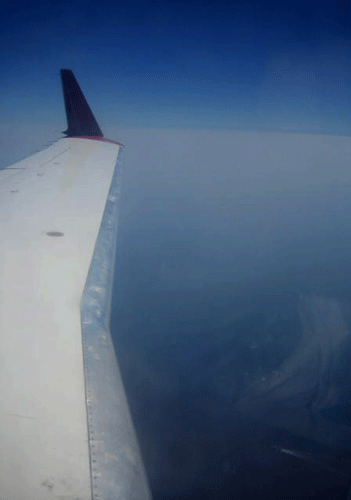
I had the pleasure of meeting collectors of one of my paintings this weekend, the circumstances being the need to repair the painting they recently had bought from one of my galleries. It was a large painting, measuring eight feet in the largest dimension and my armchair forensic analysis is that while it was securely packed within the wooden crate, somehow the lid had suffered an impact and the plywood flexed dynamically downward, snapping one large centrally placed monad (my name for the spiny sea urchin/ erizo forms in my work). It looked like it was a single event, forcing jets of paint to eject out of two lateral sides. Ultimately it was a small fix, requiring a dermatological-like excision and replacement with another monad.
The key issue for me is to restore a field of intention across the surface of the painting, banishing all accident I didn't accept in the creation of the work.
I didn't know the collectors beforehand, most of the communications coordinating the overnight visit were conducted via email. The husband met me at the airport, and we nearly missed each other since they were expecting someone who looked like the visage of Miguel Marcos, the portrait of which I have placed in the colophon advertising the upcoming show we have this September 28th. He (the collector) had printed my name on a small card, one that in a passing glance I didn't notice at first since I always expect my name -Hollingsworth- to require a card at least a half meter in length. At least that's the way it seemed to me since first grade when I usually had to linger on my penmanship assignment while everyone else was excused to the playground. It was funny to find someone via cellphone who is standing together in the same place, same crowd.
Like I said, I didn't know what kind of people I would meet: maybe they would be Russian Mafia where I would have to get patted down for weapons and repair the painting alongside tables heaped with cocaine... maybe they would be world weary transvestite entertainers a la "Cage a Follie" and I would have to part garlands of feathered boas to get to the painting... or maybe chronically overweight bankers rigged with oxygen tanks aside ashtrays of spent Cuban cigars, assisted by sexy nurses who would pat his head with perfumed embroidered handkerchiefs.
Well, almost.
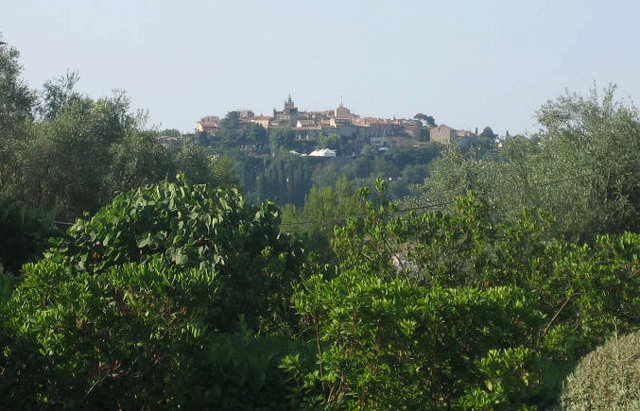
I was fortunate to meet extremely interesting people who work in the telecommunications field. And that's about all I should say. One must be careful to remain discrete. (If I might fail in this regard, it's not for lack of trying.)
Although I'd love to tell you of our conversation.
At the house, we placed the painting atop the dining room table and after the repair, we relieved the heat of the day with a swim in their pool as cicadas draped a sonic blanket over the afternoon. The conversations ranged freely, deep and candid. Their two delightful children played and warmed to the strange new visitor as the day passed. We ate dinner at the nearby hilltop town of Mougin, a night where the village invited a horde of artisans to festoon the streets, ornamenting our delicious dinner with a thick street ambience.
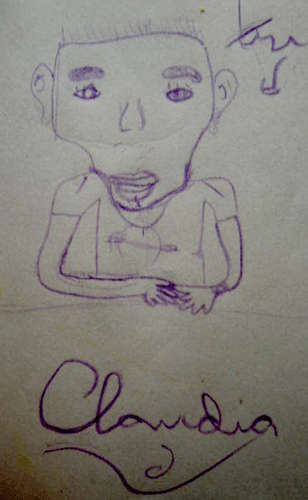
By the morning, I asked their daughter to draw my portrait.
Very nice.
July 21, 2006
Second Thought
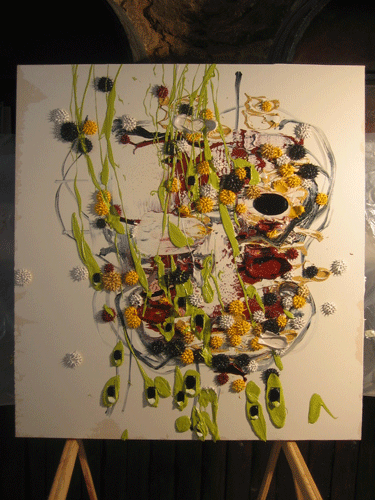
I'm rarely happy with the pics shot of finished paintings, the human eye/mind combines close ups with a long view (panorama?) so that standing before this is a bigger eyefull than what pixels can show.
Click on for the humongousness.
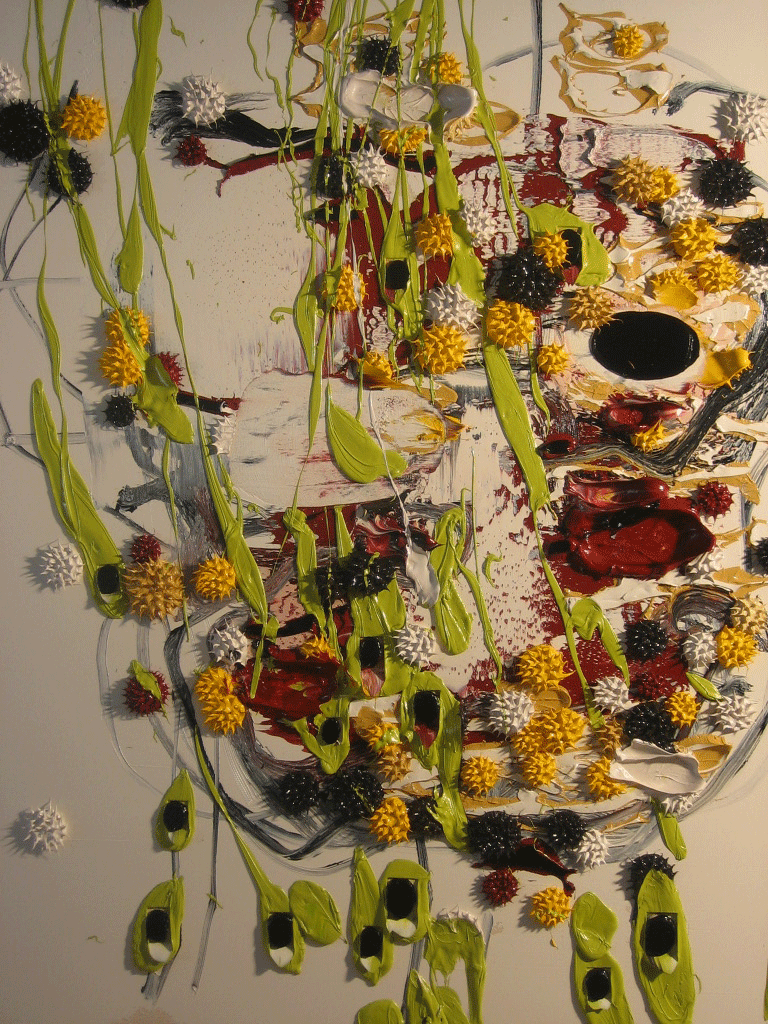
July 14, 2006
Pharmacy PRESENTS
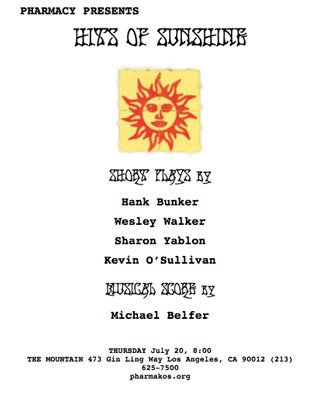
This is one of the best things going on in ChinaTown LA. My good friend Kevin O'Sullivan and his Pharmacy group are on their game. I wish I could be there.
Morning Readings
1. Conventional wisdom be damned:Strangely, experiencing a Seattle winter firsthand was not enough to make me question the myth. However, in Seattle I did become good friends with David S. Battisti, a professor of atmospheric sciences at the University of Washington. Battisti is one of those great scientists who, with relish and an air of mischief, loves to question conventional wisdom. Over the years he and I have enjoyed many a long evening indulging our shared passions for Italian cooking and wine while talking about climate research. During one of those conversations, sometime in 2000 as I recall, he brought up that he wanted to test the Gulf Stream-European climate idea. It was perfect timing, because just then I had been conducting a series of experiments with a numerical climate model, ones designed to examine the role the ocean plays in determining the global and regional features of the Earth's climate. So Battisti and I went to work.
2. Once the classes can morph one into the other, don't their distinctions become less reliable?
In art, everyone loves a bad boy -- or a wild woman.The show demonstrates that this was not always the case. The exhibition opens with a room full of solid, sober 18th Century self-portraits by artists who desperately wanted to be part of the establishment and set up self-regulating bodies such as Britain's Royal Academy to protect their status.
By century's end, more romantic notions were taking hold. Artists often depicted themselves as lone geniuses, ostracized by society but fired by an inner flame. In one of the show's most striking self-portraits, French painter Courbet stares at the viewer, wide-eyed and tousled, looking for all the world like an emotional Johnny Depp.
3. Die, Noble Savage:
However badly civilized peoples may have behaved, the 100 million or so killed by communism and the 50 million or so killed by National Socialism seem modest compared with the 2 billion or so who would have died if the casualty rates of primitive peoples had applied to the West. The verdict is not yet in, to be sure. One is reminded of the exchange between Wednesday Addams (played by the young Christina Ricci in the 1993 film Addams Family Values) and a girl at summer camp, who asks, "Why are you dressed like someone died?" to which Wednesday replies, "Wait!"
4. Drama Queen:
I learned of Sontag's death in a hotel elevator at the 2004 Modern Language Association Convention in Philadelphia. When I got to my room, I went online and Googled her name for more details. The first link I followed took me to a fan Web site, a makeshift memorial that listed choice quotations from her life?s writings. "The truth is balance," one of them read. "However the opposite of truth, which is unbalance, may not be a lie." The truth, I think, is that Sontag held a mirror to my immense desire to influence the bookish, cerebral world that I have always longed to be a part of, and at the same time showed me my equally immense capacity to be crushed by that longing. And then there is untruth. The untruth is that Susan Sontag once read a novel by Cathleen Schine and was so entertained by its subtle meditation on questions of female intellect and crippling illness that she borrowed its title for a play she'd been thinking about writing, a play about Alice James' heroic struggle with cancer, all the while certain that nobody would ever make the connection or confront her with the possibility of influence. Until we met. And that, while plainly not the truth, may not be a lie.
5. Adam Smith is not old news:
Smith set out to discern how people achieve systems of morality, economics, and government and how, by analyzing the way these work, people could better their ethical, material, and political conditions. It was a splendid opportunity to be a blowhard. Consider a recent thinker--a Herbert Marcuse, a Newt Gingrich, an Al Franken--launching into the subject. Fortunately, Smith had a knack for posing deep thoughts without making us cringe. His secret was to be an idealist without taking that impertinent and annoying next step of being a visionary. Smith didn't presume to have a "blueprint for society" and did presume that the ignorant and incompetent builders of society--he and the rest of us--couldn't follow one.
For example, in Wealth Smith denounced the Corn Laws, the British prohibitions on export of grain, as the crass inequity they were (and would prove to be when they starved my family out of Roscommon 70 years later). Then Smith didn't proceed with the rant that we now expect from people who feel themselves to be, a little too obviously, in the right. Instead Smith--keeping the inevitable follies of politics in mind--came to a humble conclusion: "We may perhaps say of it what was said of the laws of Solon, that, though not the best in itself, it is the best which the interests, prejudices, and temper of the times would admit of."
Without this humility, reading in Adam Smith's philosophical project would be as grim as living in Kim Jong Il's philosophical project, North Korea. Smith's humble attitude extended beyond the ideal to ideas themselves, to his amour propre. In an early essay, "The History of Astronomy," Smith wrote that he was "endeavoring to represent all philosophical systems as mere inventions of the imagination, to connect together the otherwise disjointed and discordant phenomena of nature." He went on to chastise himself for agreeing too much with Sir Isaac Newton's physics, making "use of language expressing [their] connecting principles as if they were the real chains which Nature makes use of to bind together her several operations."
It would take, literally, an Einstein to show how right Smith was.
6. Like I said in #2:
The name of capitalism, she points out, was long held in dishonor by those who believed in the triumph of socialism. Yet history has shown that it is capitalism, with all its injustices, that does the best job of improving the lot of the average man. The word bourgeois, which names the human being who creates and is created by capitalism, is overdue for a similar rehabilitation.8. I was going to clip the paragraph that started like this: "Women led the way", but I chose this instead:
It is not enough for the free market forces to sit back and let laissez-faire capitalism win the day. The Argentine and Brazilian experiences suggest that even with high national rates of economic growth, wealth will not automatically distribute itself downward. That the economic successes these nations enjoyed in the 90s were followed by leftist regimes in this decade indicates that free market forces must do more to make sure that the lower classes are uplifted by national economic growth.
For his part, Chavez has maintained strong popularity in Venezuela, despite a one-note oil based economy, by offering free and low cost food to the poor, Cuban medical treatment in the barrios and a vast expansion of subsidized public work "employment."
As commodity prices rise globally, driven by Chinese and Indian demand as their economies mature and grow, Latin America can now advance economically without necessarily embracing freedom in its economics or its politics. It just has to ride oil, copper, zinc, gold, and other commodity prices upward. With quasi-communist leaders distributing the goodies, downward, anti-American leftists can gain power and stay there despite the global consensus on free markets and free peoples.
Mexico has taken the first big step to stop them.
9. This quote from 2005 in the blog EU Referendum in a blogpost entitled "Smug" tells two stories: a conceptual critique of the EU and a reason to read the EU Referendum:
For all that, the A380 is an aircraft that has never left the runway and its first flight is not due to take place until this spring. Commercial service is expected in 2006.Interestingly, compared with Boeing's alternative, the 7E7 "Dreamliner", there is another "old Europe" aspect to this project. Boeing is going for a smaller aircraft, capable of servicing regional airports, transporting people directly from place to place. The idea is to give passengers a greater choice of starting points, routes and destinations, enabling them to avoid the inconvenience of travelling to the congested, high density "hubs".
Airbus, on the other hand, is going for massive centralisation, putting even more pressure on the central hubs, as its operating carriers will be forced to increase passenger traffic to meet their costs. That rather epitomises the very nature of "old Europe" ? an inflexible, centralising construct, divorced from the needs of the people.
As well as the hardware, therefore, we are also seeing an ideological battle and competition between two opposing commercial concepts. My money is on the New World.
10. In this typically great analytical blogpost from The Belmont Club, I clip twice:
If Iraq is on a blood-bespattered but upward learning curve, and Afghanistan is a stone-age battleground in which cycles and eons are the measure of time, Gaza is the playground of fantasy. Here time has stopped in the way that is only possible within an asylum.
...and if you are a participant in my artworld, would you be surprised to discover the following contingency noted in the comment section of Wretchard's blog?
The Guggenheim Foundation announced that it will build its largest museum to date in Abu Dhabi. The museum will cost $200 million dollars. A google of United Arab Emirates, Dubai, Bahrain, Qatar, and Kuwait will reveal Persian Gulf countries awash in petro-dollars which are "burning holes in their pockets." The dichotomy of the Arab world and Islam is an enigma. One brother is advancing a backward fundamentalism funded by the other whose oil dollars are also buying western amenities and materialism. How long will this symbiotic relationship continue and how much misery and devastation will it inflict on the greater Islamic world before that world realizes the madness of the hypocrisy?
11. Marx as literature:
What of Das Kapital's own literary status? Marx knew it could not be won second-hand, by the mere display of other men's flowers. In volume one he scorns those economists who "conceal under a parade of literary-historical erudition, or by an admixture of extraneous material, their feeling of scientific impotence and the eerie consciousness of having to teach others what they themselves felt to be a truly strange subject". A fear that he could himself have committed this offence may explain the anguished admission, in the afterword to its second edition, that "no one can feel the literary shortcomings of Das Kapital more strongly than I". Even so, it is surprising that so few people have even considered the book as literature. Das Kapital has spawned countless texts analysing Marx's labour theory of value or his law of the declining rate of profit, but only a handful of critics have given serious attention to Marx's own declared ambition - in several letters to Engels - to produce a work of art.
12. From Marx as literature to a sighting of Hayek in Steve LaRose's recent searching, searing and hopeful blogpost:
I guess that I need to know what "radical subjectivism" means to Ashes. My feeling is that this notion that everything is relative is unsettling to most people. It is especially bizarre to those of us who make things that enter into a market of "taste". How can I say that everything is relative and then suggest that there should be more art taught in schools? If everything is relative, then we should all "trust our hearts" and just do what we feel is right, because ultimately nothing is right. Right? This was the downfall of my teaching career and ultimately my career as an exhibiting "artist". The idea of our qualitative reality being simply a subjective leap of faith is not good for most students and even worse for those desiring valuable commodities. I sold more paintings and was a more confident teacher when I felt that what I was doing was "right" (or at the very least, on to something). But, as Will Rogers once said, "Even if you are on the right track, you'll get run over if you just sit there."Sometimes flight in the vortex may seem like downfall, when we are all actually spinning round and round. It's not over 'till it's over, Steve.
13. From Steve's "desirable commodities" to Chris Ashley's "valuable object", check out this interesting Case Study of his work undertaken by Australian research students:
What do you mean by ?independent artists?? Does that mean someone not affiliated with a gallery? If so, there are way more independent artists than there are non-independent artists (I don?t know what to call them- dependent, affiliated, sanctioned, professional, official?). There are many art worlds and many different communities. There is a huge, barely known art world of programmers, web designers, people using audio and video and performance, all kinds of image makers, etc. Most artists don?t become non-independent artists. They either get into academia or get day jobs and continue doing what they do. Some artists using technology are getting shown and sold, but it seems to me that the commodity being sold still has to have the aura of being a valuable object to it. That?s pretty hard to say about a colorful abstract image that is made of code and doesn?t? really exist, or an animated GIF projected on a wall, or an interactive web site.Once I realized the implications of "All that's Solid Melts into Air" in grad school, I took the Oedipal turn and dwelt on the stubborn facts of that which exercised my curiosity. It just so happened that we can hang these stubborn facts on a wall. If my curiosity pointed toward primarily towards the stubborn facts in sculpture, then I would have to accept the equally stubborn reality that people generally have less cubic volume than vertical square footage to accommodate an art collection. I'm not sure if Steve and Chris are seeing greener pastures in the commodified art world, but I have two thoughts in response: firstly -and not as harsh as this may sound- but we all have to pursue our curiosity and take the consequences (that this is ultimately something right and true even tough it might not seem that way at any given moment); and secondly, all art is about an investment in intrinsic value which over time, which eventually becomes extrinsic (whether it happens in our lifetimes and by what degree is beyond our power to control). What is interesting about blogs as a potential/actualized art form is that for now, they are free. I heard a dealer once say that if it doesn't sell, it isn't art. But if it isn't art before you sell it, it's a fraud.
Irony is like that.
To judge from their paintings, the impressionists led idyllic private lives ? afternoons on the river, seaside holidays, sun-dappled fields and gardens, bars, cafes, ballerinas. They painted happiness, and must surely have been happy. Sue Roe?s businesslike if sometimes gushy group biography reminds us that the contrary was true. It would be hard to find a school of painters who were subjected to more misery and humiliation, or underwent such disasters, personal and national.15. Much of this interview with Tyler Green, I agree with... except this bit:
This is a big and excellent question. Degeneration, particularly of societies, cultures, and political systems. Regardless of whether I?m in New York, LA or in between, I see artists making art about things falling apart. Look at last year?s top news stories: Iraq, Katrina, the London bombing, the Indian Ocean tsunami, the BTK serial killer, the continuing struggles of the Bush presidency, even the death of Terri Schiavo. They?re all about degeneration.
I see this simultaneously in two different ways:
-On one hand, I see our current situation in the art world as the final stages of an immense PostModern cycle. I attempted to sketch it here in this blogpost. As in the idea of a river which starts off as a cold and hard mountain stream, I believe we are in a stinking river delta stage at this time.
-On the other hand, the subject of how things fall apart is only interesting in terms of the question of how things can come together since entropy happens with or without humankind's foibles. Degeneration alone is conceptually not big news, but degeneration in terms of some construction of ideas, now there might be something to run with. The grand arc of civilization is a positive one (as in the direction of the slope but also in terms of optimism) and what is really crumbling are various forces of atavism... therefore there has always been a kind of creative destruction in the turning of civilization's gyre. Art seems to dwell on foible, mishap, the picaro, Oedipal conflict, insurrection as a kind of epic digestive process. In terms of the river model, the big question for independent thinkers is how to try to evaporate, condense and mist oneself into the mountaintops.
Snorkeler
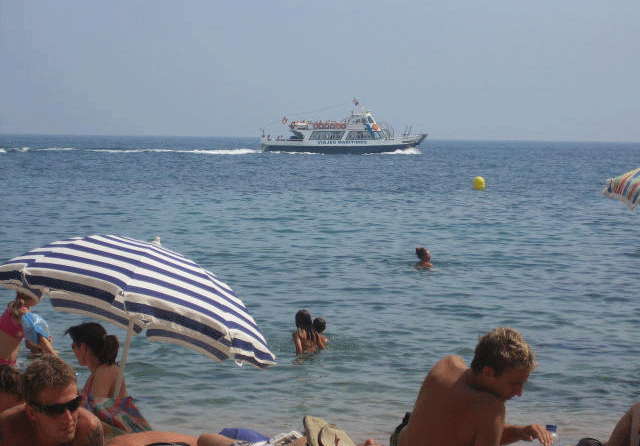
Codolar beach. In the shelter of this cove, there are a variety of underwater environments: vertical rocky wave thrashed action, sandy middle deeper water marked at the center with a yellow mooring bouy, rocky shallows inclining gently to the east where bigger fish sleep under ledges.

You can only surveil schools of fish and spy octopus and jellyfish for so long. After a while, you've got to have something to do. I myself have a choice of two tasks: to clean up the trash or build a little stone grotto by the bouy for the fishies to call home. I guess it's the architect in me, it's got to come out somehow.
Stephanie took the camera -thus the P.O.V. away from my control- and shot me as I exited from a typical outing.
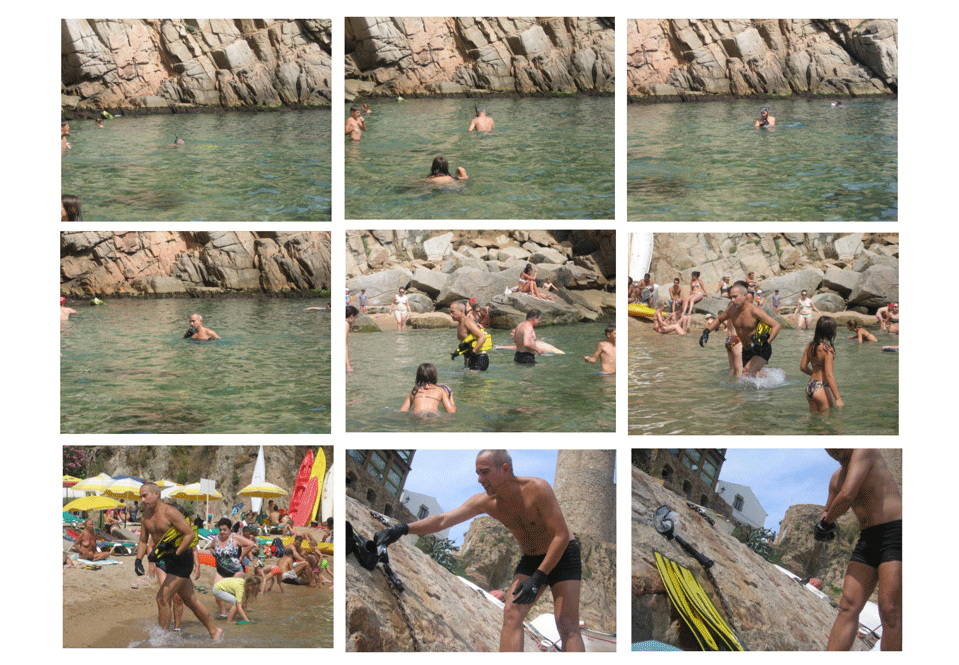
The look of grim determination is from the rocks that make the exit tricky. It's not like I am grim or determined or anything.
No, nothing like that.
But imagine being able to dial up a web address and find pics of Jonathon Lasker building and driving hobby cars... or Michelle Grabner learning the Tango... or Ed Ruscha swilling beer with his bowling league buddies. Yea, this blog stuff has a hazard with the possibility of deflating the artist mythos... let's just say that I like tto live dangerously. Besides, I think there is something nasty about the image of the artist as aloof Olympian anyway.
July 13, 2006
Ahora (Sort of)
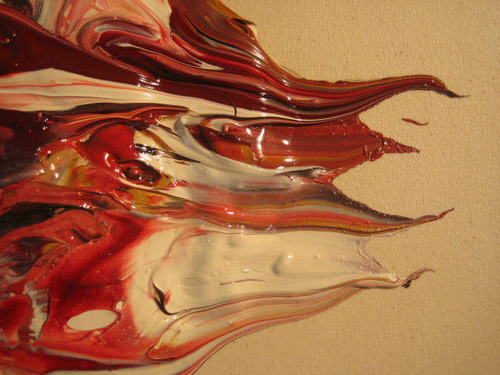
First contact.
What follows are a sequence documenting the first painting in preparation for the show in September.
(Blogpost in Progress)

I have been streaming paintings in roughly two types: one that starts allover in a screed of wet paint and another which daubs in touches, a more open approach. With this paintng, I wanted to synthesise the two.
A image in process here.
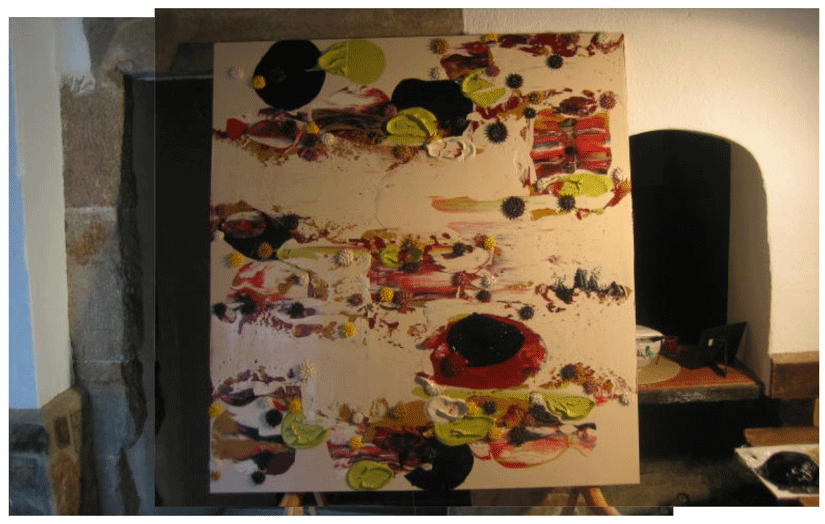
The trick is that the former tends to obliterate the latter approach and the latter's tendency is to require a virgin canvas... the key is to find a way to preserve the foundation of the canvas along the way.
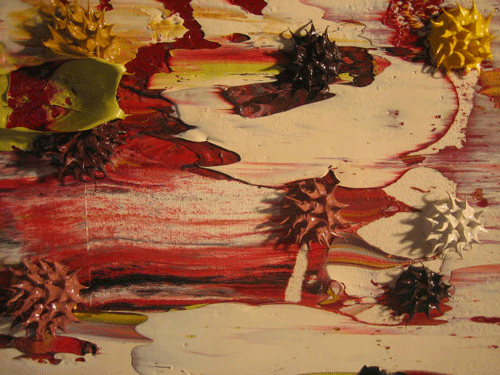
Here is a shot of the first location, a bookend to this post.
July 9, 2006
El Faro
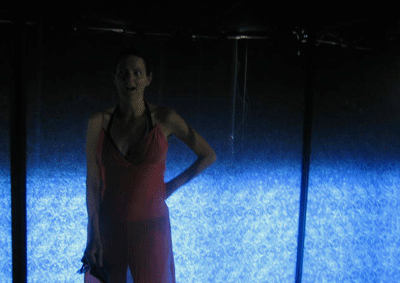
With this pic, Stephanie and I have stepped into the first room of seven which is the experience-o-rama "Center of Interpretation" for Tossa's Lighthouse, El Faro (Es Far in Catalan). At the top of Cap Tossa, the prominent rocky outcropping, the landform which defines our pueblo on the sea, the local government has invested money to reform and remake the old lighthouse into a museum and cafe. This is part of several public works projects that have sprung from a Catalan Spring, the recent economic success of Spain in general and the recent efflorescence of Catalan Nationalist spirit in particular.
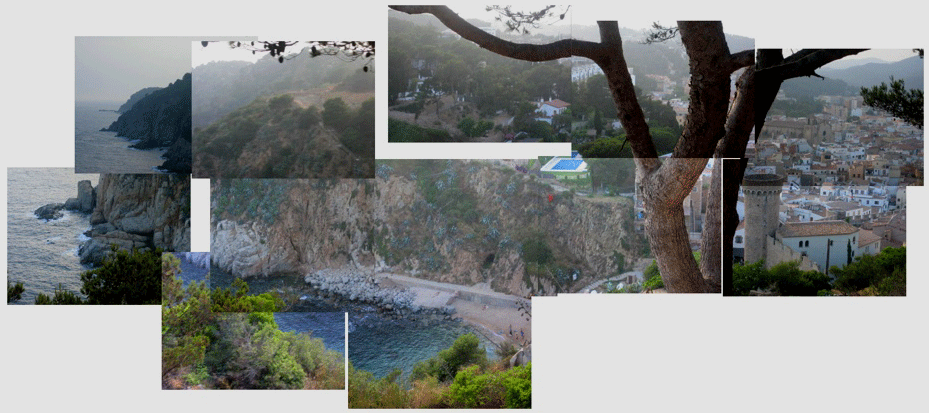
This tiled shot from the approach to the top of the hill shows Codolar below (our favorite beach here) and if you can make it out, the recently completed hiking trail along the rocky edge of the Costa Brava, another civic project that is a reinvestment in the natural beauty of Catalunya. The terrace of our house, by the way, is here in this shot.
The layout of the El Faro experience is a sequence of rooms equipped with the latest in audio visual presentation techniques that endevors to tell the story of lighthouses in general and perhaps only glancingly about the specific life of Tossa's Faro itself. But before I let loose my minor critique (already squirming out of this paragraph), here is a bit of the text from the pamphlet that comes with the show:
Since time immemorial, lighthouses have been a guiding light for navigators and sailors. Beams of light from the coast penetrating the deep blue of the ocean represented a message to the sailor, letting him know that he would soon be sfe in the harbour, that he had safely weathered the storms, that land would soon be glimpsed... that he was finally home from the sea. From the earliest days of history to more recent times, the lighthouse has played a fundamental role in the lives of all seafarers. As dusk fell, these steadfast coastal watchtowers would awaken and send out the evening's first rays from their lanterns.
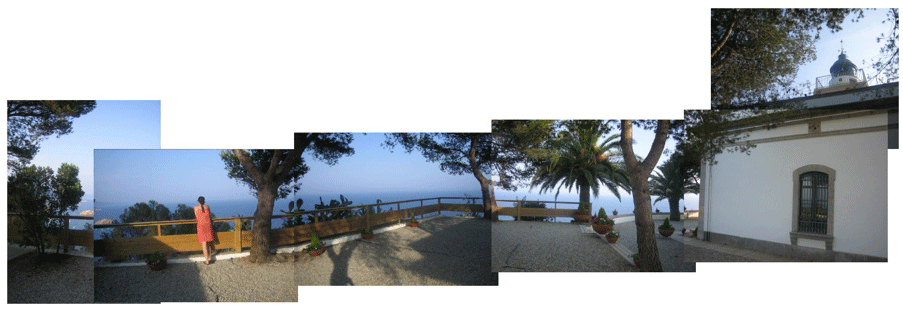
Their light would rythmically sweep the sea, providing comfort for al those who were inspired to learn the mysteries of the deep and understand its ways. The Mediterranean Lighthouse Interpretation Centre has been developed on the basis of the cultural heritage and symbolism represented by lighthouses throughour history.

Specifically created to transmit the significance of lighthouses in a practical and educational way, the Mediterranean Lighthouse Interpretation Centre is one of the most attractive cultural and entertaining sites on the Costa Brava. The Centre itself, together with its marvellous setting, make it a reference point not only for the world of lighthouses but also for our maritime heritage.
It goes on, but I'm sure you've got the point.

Well, it is indeed marvelous... and smart for the local civic elements to guard and nurture such local treasures. But nothing is perfect and in the inclination toward the better (while simultaneously bearing in mind that the best is the enemy of the better), I have a critique for The Mediterranean Lighthouse Interpretation Centre. But I tend to flinch at the jargon and overbearing institutional voice in its disposition... but then I tend to think that the worldwide triumph of advanced culture in the Western World is simultaneously a glory and a detriment since we tend to lose a measure of self criticality. The overall feel of the Center seems to be a bit impersonal to a fault.
Maybe it's the blogger in me, but what seems to be missing in this Interpretive Center are the human lives involved in the story: Who were the lighthouse keepers? Did they have families, dreams, were they lonely? Where there not lives lived between each brief handwritten log entry? And on the other end of the heroic beam of light: who were the sailors, especially as a story of the seaside fishing pueblo of Tossa de Mar. Couldn't they have harvested images of their weatherbeaten faces and recorded stories from the descendants of the local fishing families, many of whom still, to this day, guard the virtue of this little seafarer's town?
Pues, nada... as the saying goes.
July 8, 2006
Cafe Camera
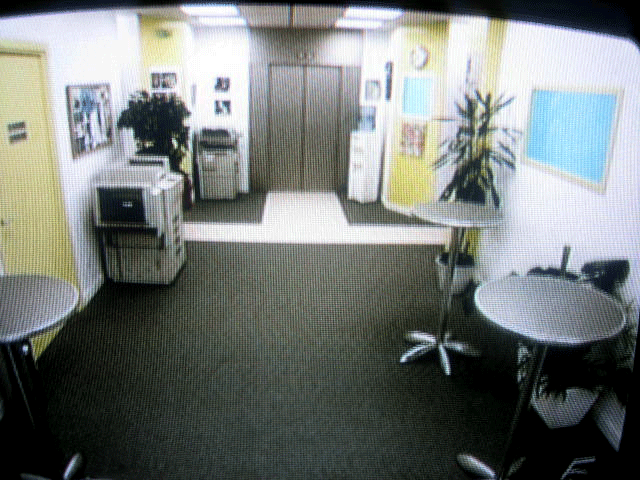
I attribute the excellence of Spanish art (I'm thinking of the design arts generally) to the rebound from the demise of the Franco era. It seems to be that there must have been a lot of work for designers of all types, for cinema and television, an efflorescence of media in the wake of a freedom speech thus newly released.
One of the supercool television shows here is new to us on our return to Spain: Cafe Camera. It is beautiful in its' simplicity: the presumption of a surviellance camera that has been installed in a typical office coffee machine.
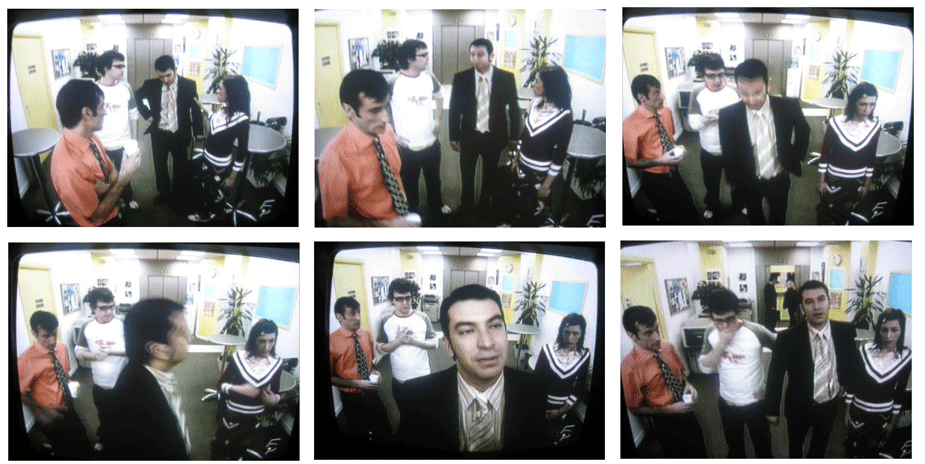
A static and unblinking point of view filming in episodic manner, a wonderful stage for showcasing comic talent. Actors step up to drop a coin for a cup of coffee and the fish eye lens distorts their faces into a natural caricature. I barely understand what the actors are saying, but the timing and physical comedy is both outrageous and subtle. I can't think of a better way to utilize comedic acting talent at their strongest point.
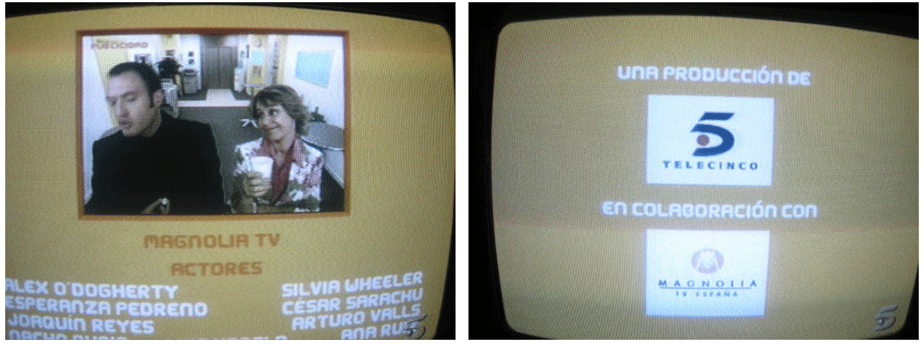
Go ahead, my "industry" friends in Los Angeles, see if you can knock this off. Their language is naughty (lots os "Ostia" and "Joder" and "puta de madre"), so its perfect for HBO. It'll be hard to duplicate the inspired grace of those who mounted this production, but if you can, then such creative theft might be the best possible compliment for the creators of Cafe Camera, Magnolia Production, TeleCinco, Espa?a .
Maybe you could flip them a percentage of profit or something.
CalaBona
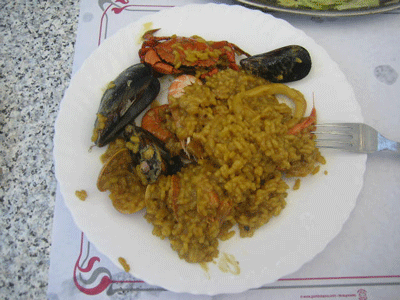
For those of you who have followed this blog for the past couple of summers, this post might be boring: After a night of drinking until the wee hours, a cita for a ninish rendezvous with Xerlo and a ride on his boat in the Mediterranean's Coasta Brava, blah, blah, yadda, yadda.
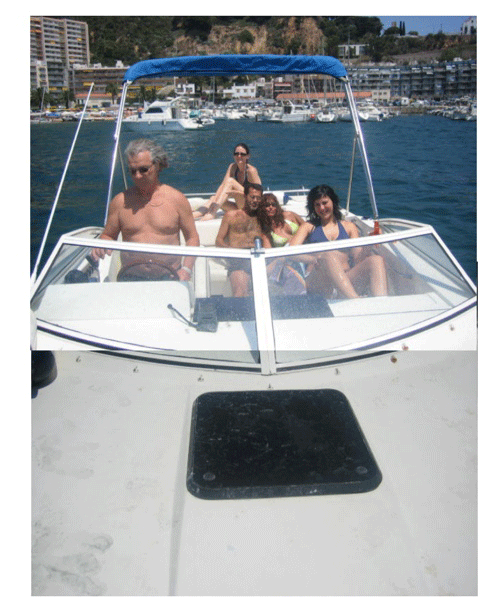
The ride southeast to the port of Blanes was miserable, as our hangovers left us limp on deck as Xerlo thumped the boat on every wave along the way.
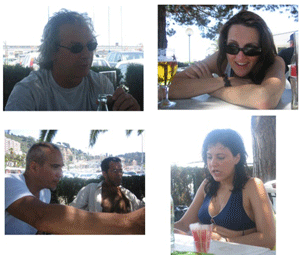
Cococolas and chips to recharge the body fluids. A refuel and a ride north to Calabona.

Calabona is a summer restaurant run by winter builder families (the only people here who work all year long) and it is accessible only by sea... or a footpath from the road above that leads from Tossa to San Felieu.
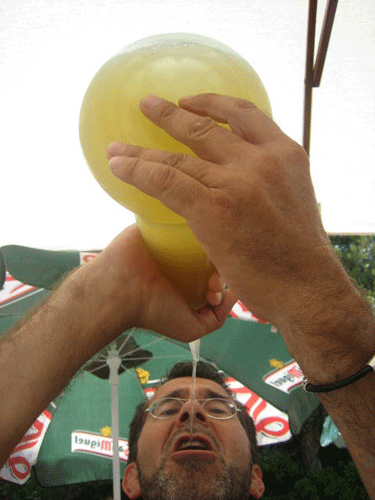
Claras (citrus+beer) drunk from purons (sp?), that classic strange glass thingy that they use to squirt the beverage into the mouth. Great for bathing siut attire.
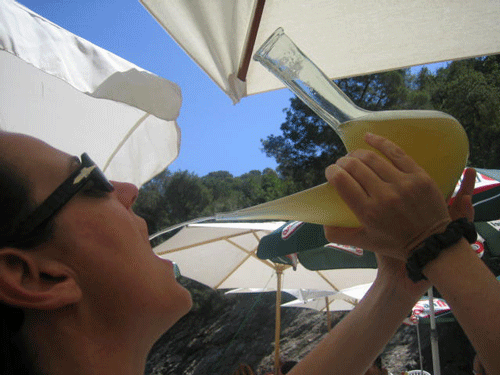
Fattened by paella, sunburned and sticky with clara, we dog paddle to the boat to return home.
Ahora (Sort of)/Admin
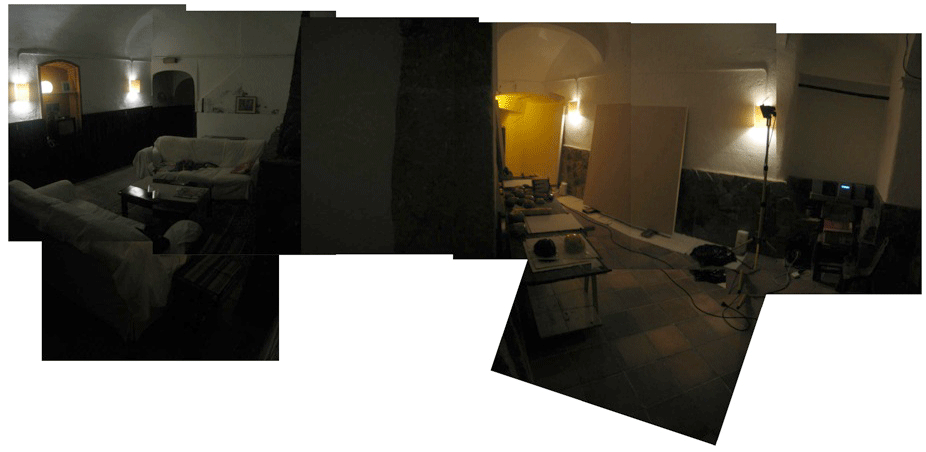
Here is a shot by night, the studio bajo. I can't deliver any more true "Ahoras" (studio pics shot and blogcast at once), but this might suffice.
I've just rolled on the last coat of matt medium and now all of the panels are prepped and ready to go. It feels like it has been a long time since I've approached a canvas... but considering that I have just recieved the last materials for the preparatioin of the panels by the middle of this week, well I guess I'm moving as fast as I can.
Here's a shot by day:

Sorry to be running behind with the mailcall. I intend to pick up the slack in a week or two. Thanks to those who were kind enough to send in a note. I've just recieved one from Chris Jagers (his fine blog is listed in the Soup of Links to your left) and since he asked a techinical question that relates to the circumstances of this Ahora, I thought it might be correct to get a jump on mailcall at this time:
Hi Dennis,I saw in a recent post that you prepare your canvas with tons of matte medium. Could you post some pictures of that? I'm curious if you use rollers, squegees, brushes or something else. I am starting to use matte medium myself, but for painting with -, but using it between layers of ink drawing. (Does that still count as a painting?) I'll include a pic.
Also, do you like having so many shows lined up one after the other? I would hate the pressure, but you seem to know what your doing. Do you wish you had time to just mess around, or think, or take a break? Your unbelievably productive.
Chris
I think of Robert Ryman as the one who sanctified the idea that the entire construction of a cuadros is in coequal terms with the paint material in terms of being qualified with the status as art material. So, yes of course, interleafing the ink with the medium would still count... if one has to count at all.
Chris, I'm sure that you've already considered using the full spectrum of prepratory media in this coequal status with finish media: gesso, gel medium, even tinting the medium with acrylic color. Since you're interleafing, why not go to town?
My friend in ChinaTown, painter Bart Exposito ('sup, Bart!), was the one who converted me to the practice of rolling on the medium with... paint rollers, a big improvement this is over my previous habit of laboriously brushing it on. The "hand" is better, more uniform and neutral, and it's faster and therefore I no longer experience the dread I once felt in the have-to-do of canvas prep. Do I use tons? Maybe. But once you've had the experience of having the oil creep into the weave of a finished canvas, an extra coat will enable a sound sleep at night. I used to brush three coats by hand and now I roll four. That seems to work alright.
Shows lined up? Well, I do what I can, what I have to do, I guess. I'm lucky to have a train of shows (toca madera, I knock on my head), that's for sure. I try to schedule them so that I'm not on a treadmill... compared to many other artists, having around two and a half shows a year is certainly not a rat race.
To keep things in perspective, I have not enjoyed real success by the standard art world formula: making the curatorial and critical short lists which would throw me into the hyper velocity treadmill of rolling prestigious international museum shows and big time A list group shows, all of which would be added atop a super pressurzed three plus shows a year. Let's call this a blessing in a clever disguise.
Otherwise, I think it's important to keep that open "messing around" feeling on par with the attitude of industry. This is how I describe my work in relation to others: "For me, work and play is one and the same." ...and therefore, and with appropriately mixed feelings, I get no real vacation however exceptional my life may seem.
But consider my situation right now: Stephanie is working for Guess? inc. at this time, and she is enjoying a Spartan (or as it might be called here in Europe, Yanqui) two week vacation. We wish we could stay together here in Tossa for the three months of painting for the show (or otherwise traveling to see more of Europe), but we do what we can. This impacts her in that I am stealing time here and there to prep/paint, time for my work (or work/play as in space/time?) while she is on her vacation -which is ultimately not fair to her on some important level. ?Que lastima! And there will be moments between paintings in the coming months when I will be snorkeling and hoisting a whiskey with friends at local bars and wishing Stephanie would be here with me.
But look, if this is the kind of pain life can bring.... venga, tio!
Perhaps, too, it's my previous training as an architect that seeps in: those guys get no break whatsoever, they work their butts off. Consider: Louis Kahn used to have a matt on the floor of his studio to steal sleep now and again during charettes. I do the same for most of the time, I had built architectural bones into a painter's body. Workaholism is as natural as a sunny day.
Enough hablabbery. Gotta go!
ps: Thanks for the subtle correction in my misspelling of "matte"
pps: I remember a studio vsit aeons ago, wherein a woman in a group asked when the show date was and I reported something similar to my current situation. I remember her face, a study in horror. For a moment, I recognised that this is probably a proper register of emotion given the stress of my exhibition calendar... but I had to arc past her fear and steele myself for the task at hand: to find a way to relax into the tension; to cut away from the disembodied, floating above myself feeling and get inside the studio, into the work/play, to truley flow, to be there.
July 5, 2006
Back in the Saddle
Woo Hoo.
I've figured it all out. (Or perhaps more acurately: I groped about under the hood of this laptop until something seemed to work for reasons that are still a mystery to me.) Anyway, I was Jones'n like crazy.
I'll harvest the news and mail; and load up a few blank blog entries to work on later. Usually, I go home and write letters to send later en bloc.
In the meantime,
I don't do this often, but let me tell you all of the series of dreams I awoke with the memory of this morning:
Dream 1:
There was a man who was running in a footrace. He stopped midway in the race to self induce vomitting, an effort to lighten the load. In the process, he poked out his larynx, rendering himself mute.Dream 2:He didn't seem too unhappy about it, and as a matter of fact, he won the race by enlarging his airway.
There was a highway accident, cars tossed to the side of the road. I rushed over to render assistance hauling a man up onto the hood of his car with the help of a few other passers by. The man was messed up like the people I saw in the news recently, the Spanish train accident. Legs bare and bleeding, his skin blackened.Dream 3:But he was smiling, he was happy. He seemed to feel lucky anyway.
There were two brujas in a house, they took on the form of squirrels. They scampered about their house the way squirrels would. The floor of the house was made of tamped earth, the arms of the women were dusty to their furry elbows.That's all.Caganers, they excreted on the floor, dirt and straw lightly coating the feces in a modest pile in the center of the room.
It was magic poop.
I awoke to a fine morning, the sky filling with clouds that promise to ease the heat of a hot summer day in early July.
July 4, 2006
Tricky Laptoppery
For the past several days, I?ve had trouble getting connected wirelessly or otherwise with my laptop. One moment I was doing fine and in the next, my connection dropped out. I?m not able to simply plug in a ADSL line into the machine and get a connection either... which was a strange problem before I was able to scan and use the various wifi signals around me.
Not having a high speed (or any speed) internet connection is mighty unsatisfying. I?ll be writhing about, trying to figure it all out.
-Stephanie has arrived safe and sound. We?ve been on a train of fun and have-to-do?s since she came in: dinners with family and friends, boating of course (thanks to Xerlo) and a paella at Calabona (pics have been shot, more to come), and today, a trip into Barcelona so she could shop the stores and I could buy the last critical item to prepare the canvas stretched panels (gallons of Golden? matt medium).
-The paint has arrived and Ramon will deliver the last bits of wood and panel to stiffen the larger panels tomorrow. I?ll be rolling on the medium and after three or foour coats and a couple of days, I can start to wrangle with the paintings that will head toward the show in Barcelona, which is set to open either the 26th or 27th of September.
-I?ve been wrapping my head around a few items stored now in my iTunes.
I?m starting to connect the dots between the "Bad at Sports" podcasts featureing Lane Relyea and Michele Grabner, and the 16 cd set of Dennis Prager?s "The Case for Judaism".
(!)
Yes, I believe there are dots there to connect. Interesting and difficult stuff. Forms and voids of one and the other seem to interlock. If you care to follow along, download the podcasts and order the Prager lectures (I find them to be wonderful and challenging). -Sorry not to be able to give you all the links,
I'm hacking away at a primitive machine in a local intenet cafe. Google will help you get there.
More to come, G-d willing.
-Young Alberto has committed himself to showing and selling art in the Plaza de Espa?a here in Tossa. Nervous and headstrong, he asked my council and my advice was that since he was going to do it anyway, he should find something wonderful about it and do it well... in a way that would make sense to a rather particular artworld, the one indicated in this weblog.
(I maintain that there are many artworlds, to each their own... but there is a group that is clustered or centered on the idea of art in the western modern (whats a better way tio identify it?)... our emergent, free, global world where the story of art has been cascading in a historical fugue, of the stories of Oedipal dissent that have been told to us in the dark slide shows of art history class and the stories we retell and tacitly concede to each other over time.)
At any rate, Alberto has hoisted himself up on the stage: he has made himself known to my community in ChinaTown Los Angeles, and especially here in Tossa/Barcelona, and especially here in Tossa where people in general don't know the artworld described above and are trigger happy to have the lad pegged on the lower rungs. Now, he?s got to shine. The big question: how does he wrangle with the deadly kitch of tourist art-for-sale and simultaneously publicly develop (he will be painting in public) his own (private?) language as a painter?
Alberto: "Dennis, do you think these drawings of Tossa will sell?"
Dennis: "No one knows what will sell, Alberto."
My advice: do it all, do everything you can think of, do anything that you think is interesting, draw the typical tourist views (if you have to, yet an open question) and find something interesting in the approach, make it your own. Find that which is intrinsically interesting to you and make it extrinsic to others. Consider every part of this experience an artworld utterance (from the set up and display as installation to your research and image/information gathering). Seriously take on the role as witness or ambassador or "son of Tossa" in your relation to the tourists who approach you, show them an aspect of this little pueblo that the other
Dennis: "You love Tossa, Alberto. Show them what that looks like."
Go, Alberto.
-Stay tuned!

